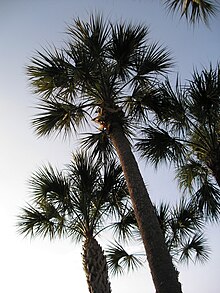Sabal
| Palmetto | |
|---|---|
 |
|
| Sabal palmetto | |
| Scientific classification | |
| Kingdom: | Plantae |
| (unranked): | Angiosperms |
| (unranked): | Monocots |
| (unranked): | Commelinids |
| Order: | Arecales |
| Family: | Arecaceae |
| Subfamily: | Coryphoideae |
| Tribe: | Corypheae |
| Subtribe: | Sabalinae |
| Genus: |
Sabal Adans. |
| Type species | |
|
Sabal adansonii Guers. |
|
| Synonyms | |
|
Inodes O.F.Cook |
|
Inodes O.F.Cook
Sabal is a genus of New World palms, commonly known as the palmetto. They are fan palms (Arecaceae tribe Corypheae), with the leaves with a bare petiole terminating in a rounded fan of numerous leaflets; in some of the species, the leaflets are joined for up to half of their length. A variable portion of the leaf petiole may remain persistent on the trunk for many years after leaf fall leaving the trunk rough and spiky, but in some, the lower trunk loses these leaf bases and becomes smooth. The fruit is a drupe.
Sabal species are used as food plants by the larvae of some Lepidoptera species including Paysandisia archon.
The species are native to the subtropical and tropical regions of the Americas, from the Gulf coast/South Atlantic states in the southeastern USA south through the Caribbean, Mexico and Central America to Colombia and Venezuela in northern South America.
Leaf fossils of Sabal lamanonis have been recovered from rhyodacite tuff of Lower Miocene age in Southern Slovakia near the town of Lučenec.
Arborescent species are often transplanted from natural stands into urban landscapes and are rarely grown in nurseries due to slow growth. Several species are cultivated as ornamental plants and because several species are relatively cold-hardy, can be grown farther north than most other palms. The central bud of Sabal palmetto is edible and, when cooked, is known as 'swamp cabbage'. Mature fronds are used as thatch and for weaving mats.
...
Wikipedia
